12 creative tips to help honor, protect, and prioritize pedestrian (on foot and on a wheelchair) mobility on local, everyday streets with Jonathon Stalls of Pedestrian Dignity and Annika Lundkvist of Pedestrian Space.
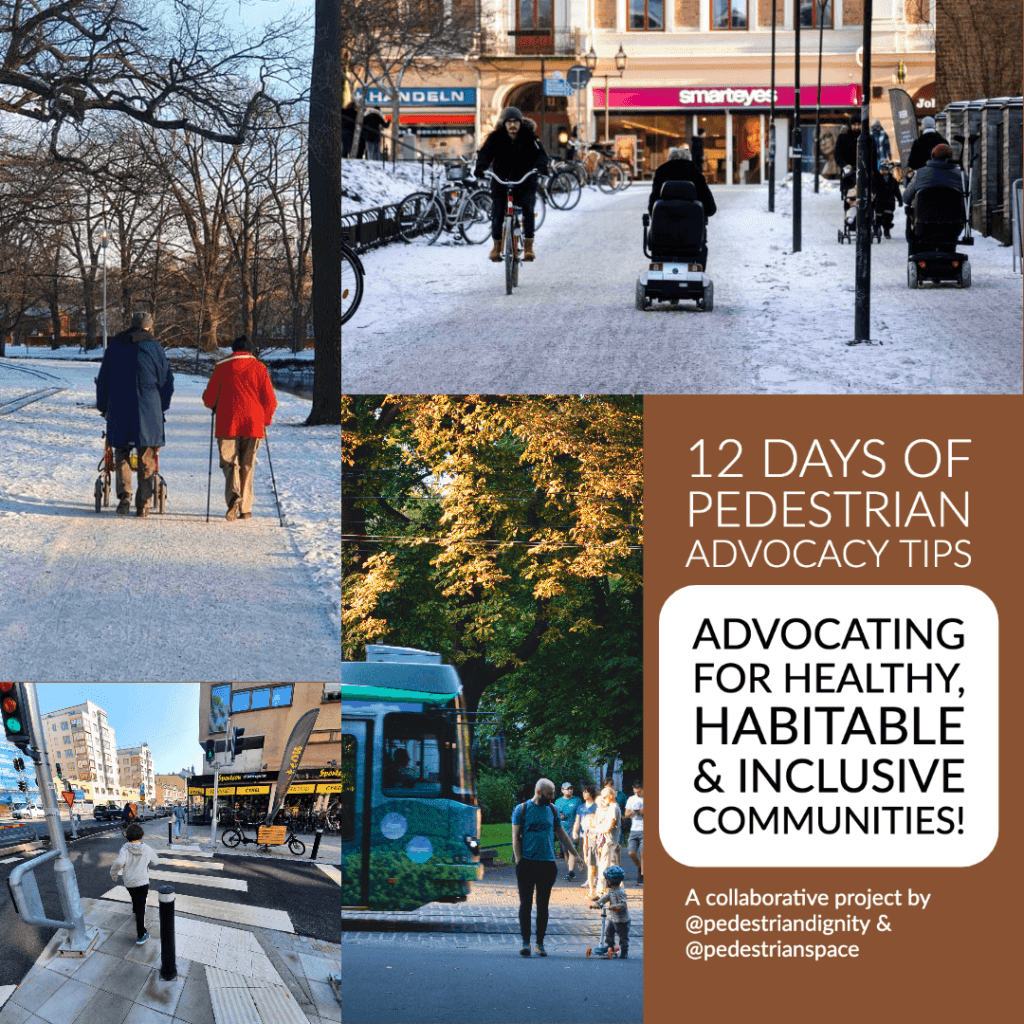
*This piece was originally published by Annika Lundkvist of Pedestrian Space and Jonathan Stalls of Pedestrian Dignity on Pedestrian Space.
1. Begin Where You Are

- Your streets, your intersections, your bus stops
- Practical access to your practical destinations
- Don’t need to wait until a “perfect” moment of walkability.
- Document barriers as well as best practices you see
For this tip, Jonathon @PedestrianDignity emphasized the importance of beginning with practical local perspectives- your streets, your intersections, your bus stops, and related pathways and access points. Focus on the practical aspects of access to your destinations and how pedestrian mobility is accommodated (or not) along the way.
For this tip, Annika @pedestrianspace emphasized simply beginning where you are in the sense of not waiting until a “perfect” moment of walkability arises. Advocacy exists due to need! Begin now documenting barriers as well as best practices that you see.
2. Research Where You Are
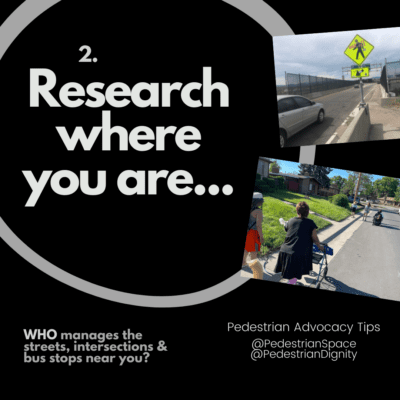
Jonathon notes:
- Who manages the streets or intersections near your home, school, or workplace?
- Learn about each city or town department that influences decisions, budgets, planning, and maintenance (public works, planning office, public health, transit agency, city council, town board, etc).
- Learn who, from those departments, manages specific decisions impacting and maintaining the streets, intersections, and bus routes near you.
3. Civic Engagement & Reporting
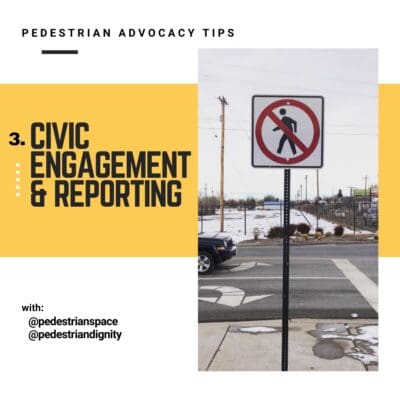
🗣Jonathon notes:
- ➡️ Get on email lists for city departments, state departments, transit agencies, local council members/state representatives, local business improvement districts, and any specific departments working on planning/infrastructure.
- ➡️ Follow their socials. Are they hard to track or follow? Tell them and push them to make it easier to engage as public stakeholders.
- ➡️ Track local elections and hold candidates accountable for pedestrian/accessibility issues.
- ➡️ Get familiar with how to best REPORT various access/safety barriers on sidewalks, intersections, bus stops, and signals to the right individuals or entities. Learn as you go! Release perfection. If you reach the wrong person or department, they will more than likely send you to the right one. This could be forms, phone numbers, or email addresses on your city, town, state, and council member websites. ✨Have photos, specific locations, and any detailed information with you to share in the email or report submission form. ✨.
4. Connect With Other Advocates & Advocacy Groups
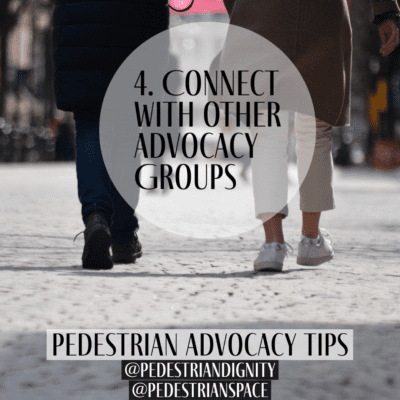
Jonathon notes “Search for them. Follow them. Tag them. Invite your people to follow them. Join their next meeting or gathering.”
In preparing this list, we asked Michael McGinn, Executive Director at America Walks for a tip and he noted to: “Join a local advocacy organization that includes walkability as a priority.” https://americawalks.org/local-walking-organizations/
I (Annika) particularly love this tip as engagement with other individuals and groups can be a real source of solidarity, inspiration as well as instructive for your own advocacy, whether you are a novice or seasoned advocate.
5. Learn How to Engage Locally
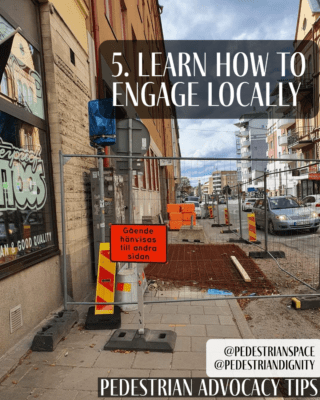
Jonathon shares these practical, public meeting tips:
- Learn when public meetings are being held related to transportation budgets, community plans, and decisions impacting your public streets and transit routes.
- Invite other residents/peers to join you and learn ahead of time if there is a process for making public comments as sometimes you need to do this well before the meeting. Make your voice heard!
- Consider becoming a member of an advisory committee or planning board!
- Report (email, online, phone) your specific safety concerns to both the city/agency and to your local planning/community committees, boards, and hearings. Send photos with exact location. Be persistent! Sometimes it takes multiple attempts.
- Ask questions about status, plans/future projects, and priorities for pedestrian-related safety/challenges.
- Share vision and demand dignity and prioritization of accessible pedestrian infrastructure
6. Start With One – One Intersection, One Street, One Bus Stop
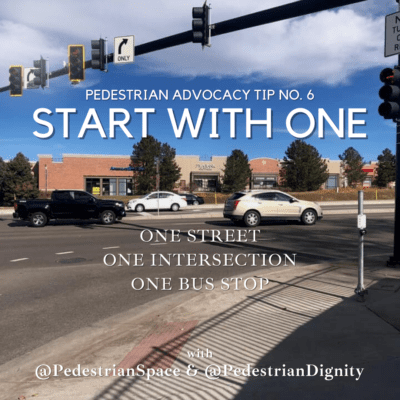
Annika wanted to share a personal story related to the tip of learning to engage locally:
“In Summer of 2020 I snapped the above photo of the sidewalk during our first few weeks living at an apartment we had moved to. I also recorded multiple videos showing how the blockage forced people onto the street and into the intersection, one of the busiest in the inner city, with no crosswalks, speedbumps, or stoplights. The scene was often very chaotic (in a city where pedestrian mobility was usually very safe and prioritized). Navigating this situation with young children and a stroller was harrowing like I was risking my life every time I just tried to walk the block. I imagine that many people (particularly disabled or with reduced mobility) avoided this block entirely because it was such a mess in terms of access and safety.
I began emailing my concerns to the city, to see who was responsible for the stalled construction and reduction of access. I finally learned that it was in fact the owner and rental company of the building we lived in who was responsible for the construction zone on the sidewalk. I wrote my concerns to them and shared some of my visual documentation that showed how unsafe the block had become for pedestrian mobility. I sent more than one email and my tone remained polite but always conveyed urgency due to the complete lack of safety for pedestrian mobility.
Not long after, construction resumed. I did not quiet down simply because construction resumed but continued to check in with the company about the estimated time that they would be finished and sidewalk access would be restored so our sidewalks would be safe and accessible again.”
*Note: The culture of local public meetings did not exist in this city, otherwise this would be a perfect example of a situation to bring to a meeting. In this particular case (and this particular culture), the primary and perhaps most effective course of action was to communicate directly with the company responsible for the blocked sidewalk. Had they been non-responsive or difficult, I would have escalated complaints to the municipality.
7. Educate Through Encouragement and Inspiration

Perhaps the best possible thing for understanding and appreciating walkability/rollability as a living concept with multiple dimensions and benefits is to truly just experience it.
However, the digital realm offers an incredible opportunity to connect, mutually inspire and educate one another about possibilities, discuss what we envision our cities being and becoming, vent about what we observe our communities lacking as well as provide real-life examples of what we aspire towards.
Jonathon notes:
How do we advocate from the realm of inspiring ‘what could be’ as well as being encouraged by what others have done?
- Showcase great examples of walkability/rollability from your own community or travels
- Affirm, amplify, and reshare the great examples you see others sharing- there can never be a shortage of positive examples of walkable communities!
- Inspire change agents, decision makers and other inhabitants in your community with the inspiring examples you are seeing in other communities
- Research the many benefits (social, physical, environmental, mental, communal) of walking or rolling more for connection and transportation – share them alongside your advocacy efforts as a way to inspire other residents, leaders, and agencies into action
8. Educate Through Stories and Lived Experience
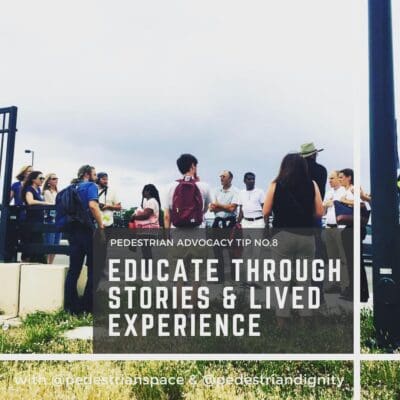
Jonathon notes:
When we honor and listen to the stories of others our hearts expand and we more easily empathize with what one goes through every day trying to get to work without a vehicle. When we ourselves experience these everyday transportation environments by foot, on a wheelchair, or by bus, we literally feel what it is like to be sprayed by slush on a slim, attached rollover curb or protected and buffered by trees on a detached, wide walkway/rollway.
Story-based, body-based learning is needed more than ever in a time when decision-making, budgeting, public hearings, and educational learning get further and further into zoom screens, email, and social media. We need more residents to be supported, trained, and cared for related to sharing what they go through to get to the bus, grocery store, and to school. We need more of the driving population (esp. planners, engineers, and public officials/representatives) to replace car trips with walking, rolling, and transit so they can be informed by what it actually FEELS like to wait at a bus stop with no shelter in the rain.
A couple of tips to bring more storytelling and lived experience into your advocacy work:
- Invite those in your life who you know depend on walking, rolling, or transit to get around to share more of their story related to what it is like for them getting from point A to point B. Budget in advance to support and value their time with a stipend or gift card.
- Make it easy for people to share or submit their stories with you and/or your advocacy efforts. Find meaningful ways to honor and thank them for offering their voices. Ask them if they would be willing to be photographed or recorded. Again, budget in advance to support them with a stipend or gift card for their time.
- Use multiple tools for sharing the stories you have collected (social media, printed posters/flyers, small cards that can be easily handed out linked to advocacy campaign, live virtual gatherings, physical walking/rolling events where stories are shared)
- If you or anyone in your organizing community does not personally experience this, commit to replacing all or part of your car trips with walking, rolling, or transit so you can first-hand feel what it is like (timing, planning, accessibility, supports like a public restroom, weather, overall safety, exposure/isolation, etc.)
- Make all or some of your meetings while moving on a practical, everyday route. Walking/rolling meetings can be such great ways to brainstorm, get connected, and actively experience an environment all at once. Invite decision-makers, community leaders, and residents with you as a way to get them connected to your team and to the campaign.
9. Share, Support, and Make Pedestrian Art: Photographing Walkability

Pedestrian advocacy can take many forms including the arts! Not only do we love sharing ART supporting art around pedestrian themes, we are also artists ourselves!
Photographing walkability, for me (Annika), is an art of capturing the every day- that “sidewalk ballet” as Jane Jacobs famously refers to, and the many rich layers of city, humanity, movement, and life.
It is also about communicating, via this visual media, the connectivity, vibrance, and quality of life that quality pedestrian mobility allows.
9. Share, Support, and Make Pedestrian Art: Artist Jonathon at https://www.intrinsicpaths.com/
Jonathon @pedestriandignity is an artist whose work you can explore and enjoy at @intrinsicpaths. This graphic features an element of his beautiful work entitled “Honor My Movement”.
He is also a writer with a book due out later this year and whose poetry “Empire Lines” is a part of the Building Denver exhibit at History Colorado.
He shares these insights about weaving art and advocacy together:
- Offer, showcase, and share art (physical prints or images of art online) resembling dignity, safety, or inspiration of walkable/accessible streets and spaces with leaders, decision-makers, and local planners
- Invite and financially support a spoken word artists or street art muralists to perform/paint at public hearings and committee meetings
- Seek and support artists who paint, photograph, draw, and use art to express beauty and barriers in the built environment
10. Host Walking and Rolling Experiences with Decision-Makers
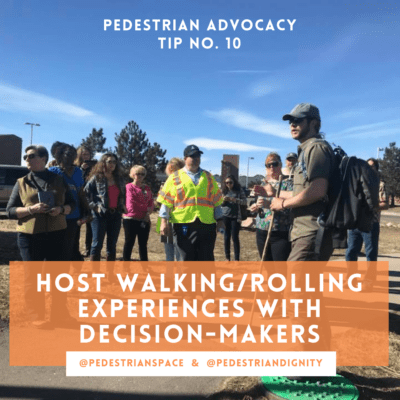
Too often we have decisions being made related to the built environment (safety, access, investment, land use, community engagement, etc) from inside of walls and behind screens. In addition to this, decision-makers themselves are more than often coming from a personal driving-centric perspective. All of this impacts the hostile nature of pedestrian networks. Simply put: we need all people who influence infrastructure, planning, zoning, transit, and transportation systems to be experiencing what people who walk, roll and take the bus go through.
I (Jonathon at Pedestrian Dignity) have hosted countless walks/rolls with decision-makers and it is always extremely positive and eye-opening. After each and every experience I feel the heart expand with empathy and new sparks of agency toward personal and systemic change.
A couple of tips for hosting your own walks/rolls with decision-makers:
- Invite others to co-host with you, especially people who use mobility devices, depend on transit, etc. Having resident/community voices with you is incredibly important.
- Scout your route from an access/safety lens and a practical trip lens. Know where the gaps are (sidewalk areas, ramps, intersections, bus stops) so you can easily point them out. Know who uses these environments so you can guide people into practical use and behavior.
- Research who lives near or uses any given intersection (workers, residents, apartments, students/families)
- Invite several departments to join you so they can collaborate on-the-spot around what it would take to make change as so many streets and intersections need multiple agencies working together (state transportation, city planners, city engineers, city public works, city council, etc)
- Encourage (and financially support if you are able!) residents to share their stories as you host your walk/roll experience. I also highly encourage using transit during your event if you can as too many decision makers do not use or depend on the local transit system.
- Invite the press and take photos/videos to storytell publicly later to increase accountability and local advocacy awareness.
- Have at least 2-3 tangible asks of YOUR public agencies as you circle up and close your experience so it doesn’t just end with a nice walk/roll. Co-create tangible follow-ups while you have everyone present and with you.
- Be persistent. It may take numerous walks/rolls with various departments!
11. Youth Engagement

How are your ideas, goals, and work in the realm of pedestrian advocacy engaging, inviting, and emerging alongside younger generations? What tools are you using and what environments are you exploring that meet younger people where they are?
Youth engagement, leadership and involvement are critical to all forms of advocacy. Not only is it direct civic engagement training/participation, but everyone involved is inspired by their vision and held more accountable towards a healthier and more connected future.
A couple of tips:
- Present and share your advocacy campaign or project with nearby schools, especially if those schools are directly impacted by the street, intersection, or systems you are organizing around
- Engage social media tools that are popular with younger generations. I (Jonathon) have been experimenting on TikTok via PedestrianDignity since June of 2021. It has been an INCREDIBLE access point to invite younger audiences into advocacy and education around the many gaps facing all who 👩🏿🦽👩🏽🦼👩🏽🦯🚶🚏
- Create a summer program or a smaller weekend/month long program of sorts that is educational around your advocacy efforts. Organize funding to support youth for their time and identify pathways of leadership for them through the program.
- Seek out youth voices and stories for various events, campaign outreach, and public hearings.
12. Research the Benefits of Walkability
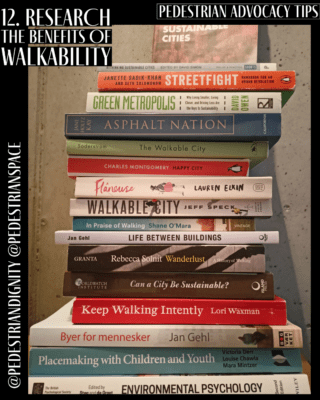
Our 12th and final tip is about researching the benefits of walkability!
Books, media articles, academic papers- we love reading to learn more about the benefits of walkability and more broadly its central role in sustainable urbanism and healthy communities. Share your findings from your reading and research alongside your advocacy efforts as a way to inspire other residents, leaders, and agencies into action.
This is a stack of some of my (Annika) recent, current, and near future reads. My digital stack of academic papers that explore the myriad benefits (health-wise, psychologically, economically, environmentally, socially…) of walkable communities is constantly growing. There is a wealth of material out there that I enjoy spotlighting here and will continue to spotlight as resources for pedestrian advocacy.
I must also mention that Jonathon, my co-host for this series, has written a book ‘WALK: Slow Down, Wake Up and Connect at 1-3 MPH” which is AVAILABLE NOW!
At the heart of advocating for walkability is advocacy for truly habitable, inclusive communities where we can thrive, move with dignity and safety as well as accessibility to truly sustainable modes of mobility.
Walkability is not just about moving on foot. Advocating for walkable cities also means advocating for those who move with wheelchairs, with walkers, strollers, and mobility canes. It means keeping in mind the diverse needs of different generations and various demographics. It means advocating for options for individuals with reduced mobility and for accessible and affordable public transit systems. Walkability connects to aspects of safety, infrastructure and built environment, local culture, policy, public transit, green space, mental/physical/emotional health, accessibility, inclusivity, and more.
Disentangling ourselves, as individuals and communities, from the car-centric paradigm that has dominated many of our societies for decades requires a lot of work and collective efforts. Our list of tips has been developed to document our own forms of advocacy with the intention of contributing to these collective efforts.
‘12 Days of Pedestrian Advocacy Tips’ is a collaborative project by Jonathon Stalls of Pedestrian Dignity and Annika Lundkvist at Pedestrian Space. It has been a wonderful ride for us to join forces, put these tips to paper, and create something from the shared passion we have for advocating for truly sustainable mobility and healthy communities.
Jonathon Stalls is a Walking Artist who spent 242 days walking across the United States in 2010 and has continued to move alongside thousands of people for thousands of miles. His artwork currently moves in the realms of pen and ink drawing, writing and poetry, storytelling with the Pedestrian Dignity campaign, economic and racial justice organizing, meditative practice, and creating/scouting long-distance walking routes. He founded Founded Walk2Connect in 2012 and is the author of the book, WALK – Slow Down, Wake Up & Connect at 1-3 Miles per Hour.
Visit Jonathon Stalls online at Pedestrian Dignity here.
Read USA Correspondent Jonathon’s content here.